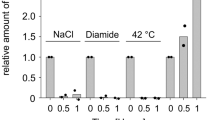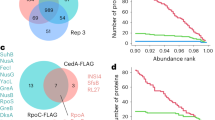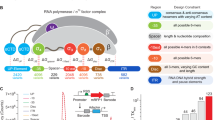Abstract
Bacterial core RNA polymerase (RNAP) must associate with a σ factor to recognize promoter sequences. Escherichia coli encodes seven σ factors, each believed to be specific for a largely distinct subset of promoters. Using microarrays representing the entire E. coli genome, we identify 87 in vivo targets of σ32, the heat-shock σ factor, and estimate that there are 120–150 σ32 promoters in total. Unexpectedly, 25% of these σ32 targets are located within coding regions, suggesting novel regulatory roles for σ32. The majority of σ32 promoter targets overlap with those of σ70, the housekeeping σ factor. Furthermore, their DNA sequence motifs are often interdigitated, with RNAPσ70 and RNAPσ32 initiating transcription in vitro with similar efficiency and from identical positions. σE-regulated promoters also overlap extensively with those for σ70. These results suggest that extensive functional overlap between σ factors is an important phenomenon.
This is a preview of subscription content, access via your institution
Access options
Subscribe to this journal
Receive 12 print issues and online access
$189.00 per year
only $15.75 per issue
Buy this article
- Purchase on Springer Link
- Instant access to full article PDF
Prices may be subject to local taxes which are calculated during checkout




Similar content being viewed by others
References
Gross, C.A., Lonetto, M. & Losick, R. Bacterial sigma factors. in Transcriptional Regulation Vol. 1 (eds. Knight, S.L. & Yamamoto, K.R.) 129–176 (Cold Spring Harbor Laboratory Press, Cold Spring Harbor, New York, USA, 1992).
Gruber, T. & Gross, C.A. Multiple sigma subunits and the partitioning of bacterial transcription space. Annu. Rev. Microbiol. 57, 441–466 (2003).
Segal, G. & Ron, E.Z. Regulation of heat-shock response in bacteria. Ann. NY Acad. Sci. 851, 147–151 (1998).
Kazmierczak, M.J., Wiedmann, M. & Boor, K.J. Alternative sigma factors and their roles in bacterial virulence. Microbiol. Mol. Biol. Rev. 69, 527–543 (2005).
Losick, R. RNA polymerase sigma factors and cell-specific gene transcription in a simple developing organism. Harvey Lect. 90, 1–17 (1994–1995).
Keseler, I.M. et al. EcoCyc: a comprehensive database resource for Escherichia coli. Nucleic Acids Res. 33, D334–D337 (2005).
Gaal, T. et al. Promoter recognition and discrimination by ESigmaS RNA polymerase. Mol. Microbiol. 42, 939–954 (2001).
Hengge-Aronis, R. Stationary phase gene regulation: what makes an Escherichia coli promoter SigmaS-selective? Curr. Opin. Microbiol. 5, 591–595 (2002).
Dupuy, B. et al. Regulation of toxin and bacteriocin gene expression in Clostridium by interchangeable RNA polymerase sigma factors. Mol. Microbiol. 60, 1044–1057 (2006).
Dominguez-Cuevas, P., Marin, P., Ramos, J.L & Marques, S. RNA polymerase holoenzymes can share a single transcription start site for the Pm promoter. Critical nucleotides in the −7 to −18 region are needed to select between RNA polymerase with Sigma38 or Sigma32. J. Biol. Chem. 280, 41315–41323 (2005).
Johnson, W.C., Moran, C.P. & Losick, R. Two RNA polymerase sigma factors from Bacillus subtilis discriminate between overlapping promoters for a developmentally regulated gene. Nature 302, 800–804 (1983).
Newlands, J.T., Gaal, T., Mecsas, J. & Gourse, R.L. Transcription of the Escherichia coli rrnB P1 promoter by the heat shock RNA polymerase (E sigma 32) in vitro. J. Bacteriol. 175, 661–668 (1993).
Wang, P.Z. & Doi, R.H. Overlapping promoters transcribed by Bacillus subtilis Sigma 55 and Sigma 37 RNA polymerase holoenzymes during growth and stationary phases. J. Biol. Chem. 259, 8619–8625 (1984).
Tatti, K.M. & Moran, C.P. Utilization of one promoter by two forms of RNA polymerase from Bacillus subtilis. Nature 314, 190–192 (1985).
Grossman, A.D., Straus, D.B., Walter, W.A. & Gross, C.A. Sigma 32 synthesis can regulate the synthesis of heat shock proteins in Escherichia coli. Genes Dev. 1, 179–184 (1987).
Wang, Y. & deHaseth, P.L. Sigma 32-dependent promoter activity in vivo: sequence determinants of the groE promoter. J. Bacteriol. 185, 5800–5806 (2003).
Lemaux, P.G., Herendeen, S.L., Bloch, P.L. & Neidhardt, F.C. Transient rates of synthesis of individual polypeptides in E. coli following temperature shifts. Cell 13, 427–434 (1978).
Zhao, K., Liu, M. & Burgess, R.R. The global transcriptional response of Escherichia coli to induced Sigma 32 protein involves Sigma 32 regulon activation followed by inactivation and degradation of Sigma 32 in vivo. J. Biol. Chem. 280, 17758–17768 (2005).
Datsenko, K.A. & Wanner, B.L. One-step inactivation of chromosomal genes in Escherichia coli K-12 using PCR products. Proc. Natl. Acad. Sci. USA 97, 6640–6645 (2000).
Butland, G. et al. Interaction network containing conserved and essential protein complexes in Escherichia coli. Nature 433, 531–537 (2005).
Wade, J.T., Reppas, N.B., Church, G.M. & Struhl, K. Genomic analysis of LexA binding reveals the permissive nature of the Escherichia coli genome and identifies unconventional target sites. Genes Dev. 19, 2619–2630 (2005).
Grainger, D.C., Hurd, D., Harrison, M., Holdstock, J. & Busby, S.J. Studies of the distribution of Escherichia coli cAMP-receptor protein and RNA polymerase along the E. coli chromosome. Proc. Natl. Acad. Sci. USA 102, 17693–17698 (2005).
Raffaelle, M., Kanin, E.I., Vogt, J., Burgess, R.R. & Ansari, A.Z. Holoenzyme switching and stochastic release of Sigma factors from RNA polymerase in vivo. Mol. Cell 20, 357–366 (2005).
Wade, J.T. & Struhl, K. Association of RNA polymerase with transcribed regions in Escherichia coli. Proc. Natl. Acad. Sci. USA 101, 17777–17782 (2004).
Richmond, C.S., Glasner, J.D., Mau, R., Jin, H. & Blattner, F.R. Genome-wide expression profiling in Escherichia coli K-12. Nucleic Acids Res. 27, 3821–3835 (1999).
Liu, Y. et al. A suite of web-based programs to search for transcriptional regulatory motifs. Nucleic Acids Res. 32, W204–W207 (2004).
Cowing, D.W. et al. Consensus sequence for Escherichia coli heat shock gene promoters. Proc. Natl. Acad. Sci. USA 82, 2679–2683 (1985).
Rhodius, V.A., Suh, W.C., Nonaka, G., West, J. & Gross, C.A. Conserved and variable functions of the SigmaE stress response in related genomes. PLoS Biol. 4, e2 (2006).
Nonaka, G., Blankschien, M., Herman, C., Gross, C.A. & Rhodius, V.A. Regulon and promoter analysis of the E. coli heat shock factor, Sigma 32, reveals a multifaceted cellular response to heat stress. Genes Dev. 20, 1776–1789 (2006).
Kawano, M., Reynolds, A.A., Miranda-Rios, J. & Storz, G. Detection of 5′- and 3′-UTR-derived small RNAs and cis-encoded antisense RNAs in Escherichia coli. Nucleic Acids Res. 33, 1040–1050 (2005).
Zhou, Y.N., Kusukawa, N., Erickson, J.W., Gross, C.A. & Yura, T. Isolation and characterization of Escherichia coli mutants that lack the heat shock sigma factor Sigma 32. J. Bacteriol. 170, 3640–3649 (1988).
Charpentier, B. & Branlant, C. The Escherichia coli gapA gene is transcribed by the vegetative RNA polymerase holoenzyme E Sigma 70 and by the heat shock RNA polymerase E Sigma 32. J. Bacteriol. 176, 830–839 (1994).
Kourennaia, O.V., Tsujikawa, L. & deHaseth, P.L. Mutational analysis of Escherichia coli heat shock transcription factor Sigma 32 reveals similarities with Sigma 70 in recognition of the -35 promoter element and differences in promoter DNA melting and -10 recognition. J. Bacteriol. 187, 6762–6769 (2005).
Erickson, J.W., Vaughn, V., Walter, W.A., Neidhardt, F.C. & Gross, C.A. Regulation of the promoters and transcripts of rpoH, the Escherichia coli heat shock regulatory gene. Genes Dev. 1, 419–432 (1987).
Eichenberger, P. et al. The program of gene transcription for a single differentiating cell type during sporulation in Bacillus subtilis. PLoS Biol. 2, e328 (2004).
Wang, S.T. et al. The forespore line of gene expression in Bacillus subtilis. J. Mol. Biol. 358, 16–37 (2006).
Popham, D.L. & Setlow, P. Cloning, nucleotide sequence, and regulation of the Bacillus subtilis pbpF gene, which codes for a putative class A high-molecular-weight penicillin-binding protein. J. Bacteriol. 175, 4870–4876 (1993).
Ramirez, M.I., Castellanos-Juarez, F.X., Yasbin, R.E. & Pedraza-Reyes, M. The ytkD (mutTA) gene of Bacillus subtilis encodes a functional antimutator 8-Oxo-(dGTP/GTP)ase and is under dual control of Sigma A and Sigma F RNA polymerases. J. Bacteriol. 186, 1050–1059 (2004).
Paul, S., Zhang, X. & Hulett, F.M. Autoinduction of Bacillus subtilis phoPR operon transcription results from enhanced transcription from EsigmaA- and EsigmaE- responsive promoters by phosphorylated PhoP. J. Bacteriol. 186, 4262–4275 (2004).
Nudler, E., Gusarov, I. & Bar-Nahum, G. Methods of walking with the RNA polymerase. Methods Enzymol. 371, 160–169 (2003).
Borukhov, S. & Goldfarb, A. Recombinant Escherichia coli RNA polymerase: purification of individually overexpressed subunits and in vitro assembly. Protein Expr. Purif. 4, 503–511 (1993).
Nguyen, L.H., Jensen, D.B. & Burgess, R.R. Overproduction and purification of Sigma 32, the Escherichia coli heat shock transcription factor. Protein Expr. Purif. 4, 425–433 (1993).
Breyer, M.J., Thompson, N.E. & Burgess, R.R. Identification of the epitope for a highly cross-reactive monoclonal antibody on the major Sigma factor of bacterial RNA polymerase. J. Bacteriol. 179, 1404–1408 (1997).
Bar-Nahum, G. & Nudler, E. Isolation and characterization of Sigma70-retaining transcription elongation complexes from Escherichia coli. Cell 106, 443–451 (2001).
Acknowledgements
We thank G. Butland, J. Greenblatt and A. Emili (University of Toronto) for the TAP-tagged rpoH strain, N. Reppas, R.J. Geisberg, Z. Moqtaderi, M. Schwabish, X. Fan and L.T. Westblade for helpful discussions and C. Baisden for expert technical assistance. We also thank C. Gross for communicating results before publication. J.T.W. was supported by a Charles A. King Trust Postdoctoral Fellowship, Bank of America, Co-Trustee. This work was supported by US National Institutes of Health grants GM30186 (K.S.), and GM72814 and GM58750 (E.N.).
Author information
Authors and Affiliations
Corresponding authors
Ethics declarations
Competing interests
The authors declare no competing financial interests.
Supplementary information
Supplementary Fig. 1
Purified σ factors. (PDF 183 kb)
Supplementary Fig. 2
Formation of the promoter-proximal elongation complex (EC18) by Eσ70 and Eσ32 at the groE template. (PDF 87 kb)
Supplementary Fig. 3
Overlap between σE targets and targets of σ70. (PDF 99 kb)
Supplementary Fig. 4
Transcription from σE promoters by Eσ70 in vitro. (PDF 147 kb)
Supplementary Table 1
Summary of genome coordinates used in analyses. (XLS 142 kb)
Supplementary Data
Transcript map and genome-wide binding data for σ70. (PDF 88 kb)
Rights and permissions
About this article
Cite this article
Wade, J., Roa, D., Grainger, D. et al. Extensive functional overlap between σ factors in Escherichia coli. Nat Struct Mol Biol 13, 806–814 (2006). https://doi.org/10.1038/nsmb1130
Received:
Accepted:
Published:
Issue Date:
DOI: https://doi.org/10.1038/nsmb1130
This article is cited by
-
Reactive oxygen species accumulation is synchronised with growth inhibition of temperature-sensitive recAts polA Escherichia coli
Archives of Microbiology (2022)
-
Temporal evolution of master regulator Crp identifies pyrimidines as catabolite modulator factors
Nature Communications (2021)
-
Redefining fundamental concepts of transcription initiation in bacteria
Nature Reviews Genetics (2020)
-
A unified resource for transcriptional regulation in Escherichia coli K-12 incorporating high-throughput-generated binding data into RegulonDB version 10.0
BMC Biology (2018)
-
Auxotrophy to Xeno-DNA: an exploration of combinatorial mechanisms for a high-fidelity biosafety system for synthetic biology applications
Journal of Biological Engineering (2018)



